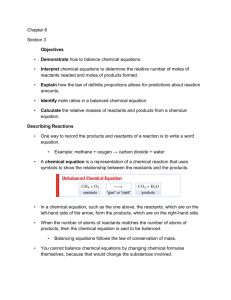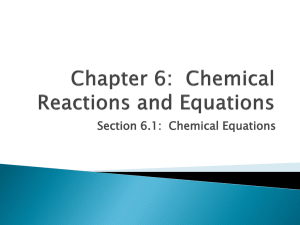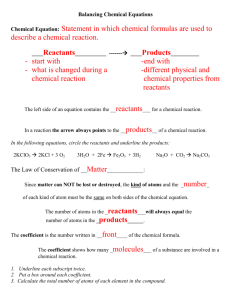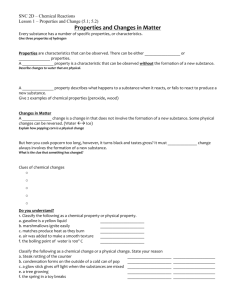File
advertisement
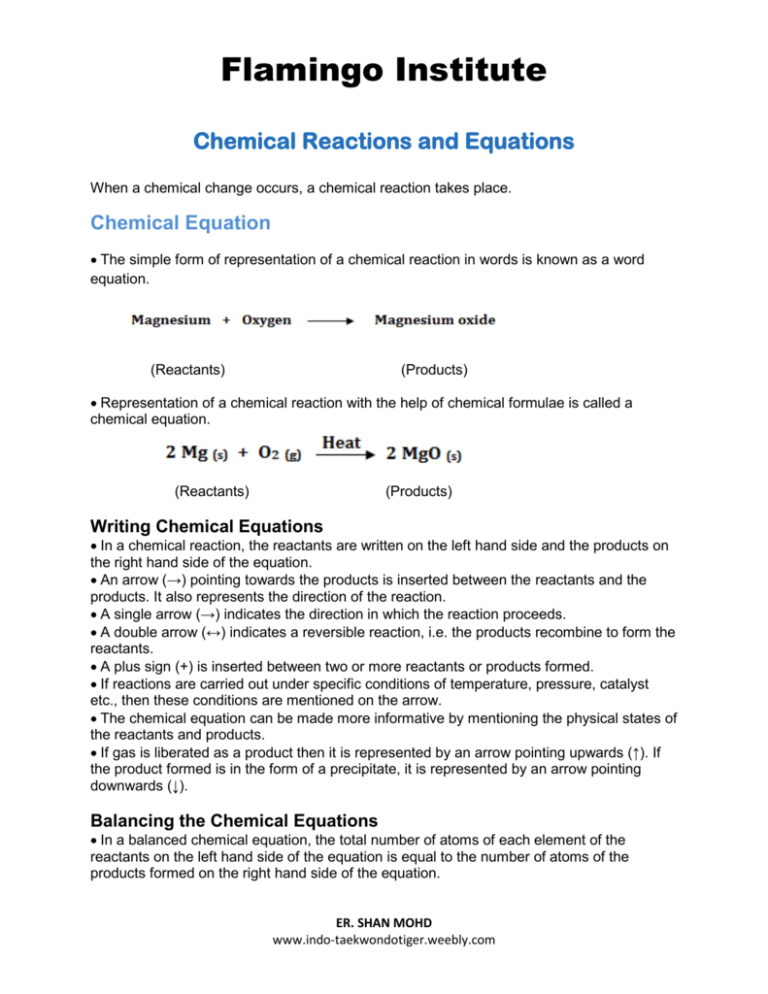
Flamingo Institute Chemical Reactions and Equations When a chemical change occurs, a chemical reaction takes place. Chemical Equation The simple form of representation of a chemical reaction in words is known as a word equation. (Reactants) (Products) Representation of a chemical reaction with the help of chemical formulae is called a chemical equation. (Reactants) (Products) Writing Chemical Equations In a chemical reaction, the reactants are written on the left hand side and the products on the right hand side of the equation. An arrow (→) pointing towards the products is inserted between the reactants and the products. It also represents the direction of the reaction. A single arrow (→) indicates the direction in which the reaction proceeds. A double arrow (↔) indicates a reversible reaction, i.e. the products recombine to form the reactants. A plus sign (+) is inserted between two or more reactants or products formed. If reactions are carried out under specific conditions of temperature, pressure, catalyst etc., then these conditions are mentioned on the arrow. The chemical equation can be made more informative by mentioning the physical states of the reactants and products. If gas is liberated as a product then it is represented by an arrow pointing upwards (↑). If the product formed is in the form of a precipitate, it is represented by an arrow pointing downwards (↓). Balancing the Chemical Equations In a balanced chemical equation, the total number of atoms of each element of the reactants on the left hand side of the equation is equal to the number of atoms of the products formed on the right hand side of the equation. ER. SHAN MOHD www.indo-taekwondotiger.weebly.com Flamingo Institute The total mass of the reactants is equal to the total mass of the products or the number of atoms of each element before the reaction and after the reaction is equal. Steps Involved in Balancing a Chemical Equation Consider the chemical reaction between magnesium and oxygen to understand the steps involved in balancing a chemical equation. Step 1 Let us first write the word equation for this reaction. Magnesium + Oxygen → Magnesium oxide Step 2 Write the chemical equation for the reaction between magnesium and oxygen. Mg + O2 → MgO Step 3 Count the number atoms of an element occurring on both L.H.S. and R.H.S. in this equation. Mg + O2 → MgO Component Reactant Product Magnesium Oxygen 1 2 1 1 This is an unbalanced equation. Step 4 To balance a chemical equation, first draw boxes around each formula. Do not change anything inside the boxes while balancing the equation. Choose a reactant or a product which has the maximum number of atoms in it. In that compound, select the element which has the maximum number of atoms. In this equation we shall select MgO i.e. magnesium oxide and the element oxygen in it. To balance the oxygen atoms, let us multiply magnesium oxide molecule by 2 on the right hand side. The equation can now be expressed as, Component Magnesium Oxygen Reactant 1 2 Product 1x2=2 1x2=2 ER. SHAN MOHD www.indo-taekwondotiger.weebly.com Flamingo Institute Step 5 There are two oxygen atoms on either side of the equation but one magnesium atom on the reactant's side and two on the product's side. Therefore, multiply the magnesium atom by 2 on the left hand side. Component Magnesium Oxygen Reactant 1x2=2 2 Product 1x2=2 1x2=2 Balanced equation is, The number of atoms of each element of reactants = The number of atoms of each element of products Step 6 Writing Specific Conditions on the Arrow The reaction is carried out in the presence of ‘Heat’. On heating, magnesium combines with oxygen present in air to form magnesium oxide. Step 7 Writing Symbols of Physical States Using these steps, you can balance any chemical equation. Types of Chemical Reactions Combination Reaction When two or more substances combine to form a single product, the reaction is known as a combination reaction. For example: In the laboratory, iron sulphide is prepared by mixing iron and sulphur. Fe(s) + S(s) FeS(s) Endothermic Reaction: The reactions accompanied by the absorption of heat are called endothermic reactions. Exothermic Reaction: The reactions accompanied by the evolution of heat are called endothermic reactions. ER. SHAN MOHD www.indo-taekwondotiger.weebly.com Flamingo Institute Decomposition Reaction A chemical reaction in which a single compound splits into two or more simple substances is called a decomposition reaction. For example: When mercuric oxide is heated in a crucible, the orange-red powder begins to darken and a silver mirror begins to deposit on the cooler parts of the crucible. 2HgO(s) Mercuric oxide 2Hg(s) + O2 ↑ Mercury Oxygen Thermal Decomposition Reaction: The decomposition reactions carried out by heating are known as thermal decomposition reactions. Photochemical reaction: The chemical reactions which proceed with the absorption of light energy are called photochemical reactions. Displacement Reaction Reactions in which the more reactive element displaces the less reactive element from its compound are called displacement reactions. For example: Zinc displaces copper in copper sulphate to form zinc sulphate. Zn(s) + CuSO4 (aq) ZnSO4 (aq) + Zinc Copper sulphate Zinc sulphate Cu(s) Copper Double Displacement Reaction Reactions in which ions of the reactants exchange places to form two new compounds, are called double displacement reactions. For example: Sodium hydroxide reacts with hydrochloric acid to form sodium chloride and water. NaOH(aq) + HCl(aq) NaCl(aq) + H2O(l) Oxidation Reactions Reactions which involve the addition of oxygen or the removal of hydrogen are called oxidation reactions. For example: C(s) + 2H2 (g) CH4 (g) Reduction Reactions Chemical reactions in which the reactants gain hydrogen are reduction reactions. For example: Fe2O3 + 3CO 2Fe + 3CO2↑ Ferric oxide Carbon monoxide Iron Carbon dioxide ER. SHAN MOHD www.indo-taekwondotiger.weebly.com Flamingo Institute Redox Reaction The chemical reaction in which oxidation and reduction takes place simultaneously is known as a redox reaction. Corrosion The slow process of decay and destruction of metals due to the action of air, moisture or acids is called corrosion. For example: Iron combines with oxygen present in the air, in the presence of water, to form a red-brown flaky substance called rust. This process is commonly called the rusting of iron. The chemical formula of rust is Fe2O3. x H2O. Prevention of Corrosion Corrosion damages buildings, bridges, ships, automobiles and other articles made of iron. Hence, prevention of corrosion is necessary. This will not only save money but can also prevent the occurrence of accidents. It can be prevented by processes like galvanising and electroplating with other metals. Rancidity Oils and fats react with oxygen and get oxidised or turn rancid. This process is called rancidity. Rancidity can be prevented by keeping food in air tight containers or by using antioxidants. Antioxidants are used to prevent oxidation of food containing fats and oils. Storage of food in air tight containers also decelerates oxidation. ER. SHAN MOHD www.indo-taekwondotiger.weebly.com
